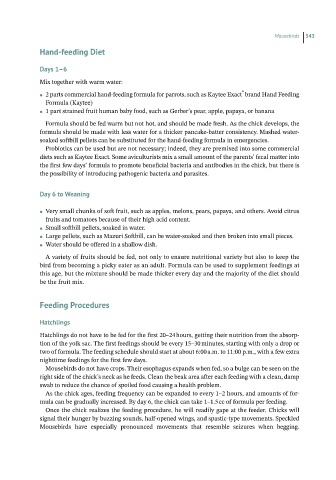Page 544 - Hand rearing birds second
P. 544
Mousebirds 543
Hand-feedingDiet
Days1–6
Mix together with warm water:
®
2 parts commercial hand-feeding formula for parrots, such as Kaytee Exact brand Hand Feeding
●
Formula (Kaytee)
1 part strained fruit human baby food, such as Gerber’s pear, apple, papaya, or banana
●
Formula should be fed warm but not hot, and should be made fresh. As the chick develops, the
formula should be made with less water for a thicker pancake-batter consistency. Mashed water-
soaked softbill pellets can be substituted for the hand-feeding formula in emergencies.
Probiotics can be used but are not necessary; indeed, they are premixed into some commercial
diets such as Kaytee Exact. Some aviculturists mix a small amount of the parents’ fecal matter into
the first few days’ formula to promote beneficial bacteria and antibodies in the chick, but there is
the possibility of introducing pathogenic bacteria and parasites.
Day6to Weaning
Very small chunks of soft fruit, such as apples, melons, pears, papaya, and others. Avoid citrus
●
fruits and tomatoes because of their high acid content.
Small softbill pellets, soaked in water.
●
Large pellets, such as Mazuri Softbill, can be water-soaked and then broken into small pieces.
●
Water should be offered in a shallow dish.
●
A variety of fruits should be fed, not only to ensure nutritional variety but also to keep the
bird from becoming a picky eater as an adult. Formula can be used to supplement feedings at
this age, but the mixture should be made thicker every day and the majority of the diet should
be the fruit mix.
FeedingProcedures
Hatchlings
Hatchlings do not have to be fed for the first 20–24 hours, getting their nutrition from the absorp-
tion of the yolk sac. The first feedings should be every 15–30 minutes, starting with only a drop or
two of formula. The feeding schedule should start at about 6:00 a.m. to 11:00 p.m., with a few extra
nighttime feedings for the first few days.
Mousebirds do not have crops. Their esophagus expands when fed, so a bulge can be seen on the
right side of the chick’s neck as he feeds. Clean the beak area after each feeding with a clean, damp
swab to reduce the chance of spoiled food causing a health problem.
As the chick ages, feeding frequency can be expanded to every 1–2 hours, and amounts of for-
mula can be gradually increased. By day 6, the chick can take 1–1.5 cc of formula per feeding.
Once the chick realizes the feeding procedure, he will readily gape at the feeder. Chicks will
signal their hunger by buzzing sounds, half-opened wings, and spastic-type movements. Speckled
Mousebirds have especially pronounced movements that resemble seizures when begging.

